Exploring the Many Types of Tulip Bulbs & Blooms
Few flowers can match the charm, variety, and pure springtime joy of tulips. From their humble botanical ancestors to today’s dazzling hybrids, tulips offer an array of shapes, colors, and bloom times—there’s truly a tulip for every garden style. While most divisions of tulips have an average height or expected bloom time that’s common among the members, we must remember that nature can’t always be categorized, and there are occasionally outliers.
Understanding the differences in height, petal form, and flowering season not only helps us create more vibrant displays, but also ensures that our gardens bloom in succession for weeks on end. Don’t let the different classes confuse you. All you need to know is that the major groups bloom at different times, in succession, just like a flower parade. By getting to know the characteristics of each tulip type, we can choose varieties that match the style, climate, and mood we’re aiming to express in our spring garden. If you plant some for each time period this fall, you will have at least two to three months of fantastic blooms in spring. Here’s a look at some of the most beloved types and what makes each one so special.
Single Early Tulips (Early Spring)
These are among the first to greet spring with pops of color, often blooming in April. With one layer of petals and sturdy stems, they can withstand unpredictable early-spring weather. Their neat, classic shape is perfect for formal plantings or early bouquets. Single early tulips tend to be compact, sturdy plants that are great for early forcing for cut flower or pot production. In landscapes, place your single early tulips in the front, or in borders.
Key characteristics:
- Bloom time: Early to mid-spring
- Height: 10–16 inches tall
- Flower form: Classic single cup shape
Double Early Tulips (Early Spring)
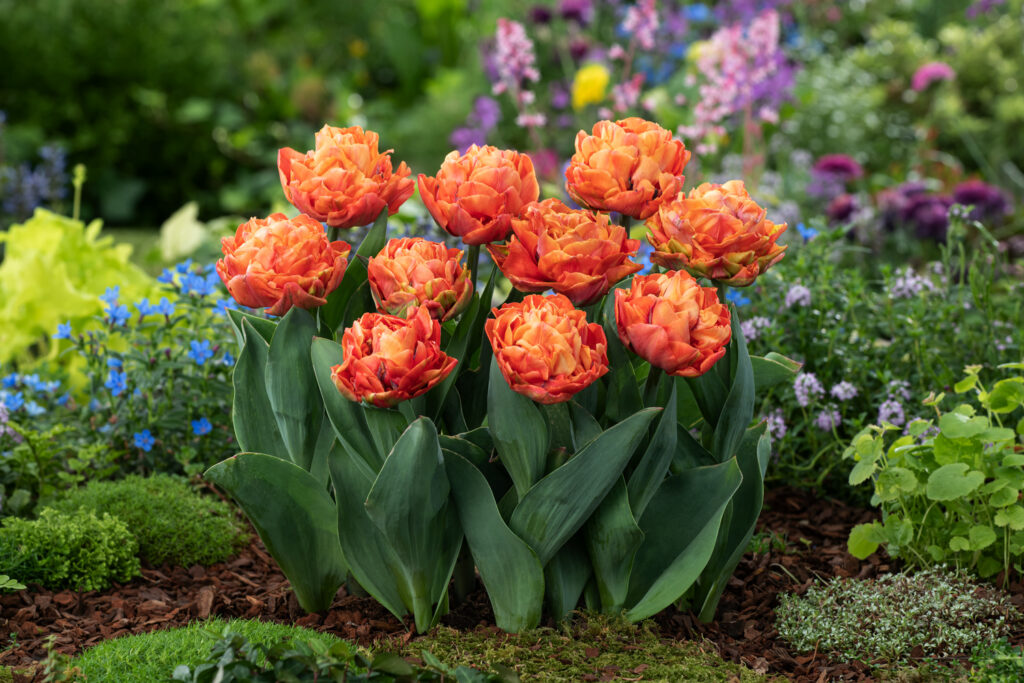
These tulips are prized for their lush, peony-like blooms that create fluffy, layered petals giving these blooms a luxurious feel. Our Royal Acres Tulip is a perfect example. They open early in the season, usually in April and early May, and offer extra texture and fullness in the garden or vase. Their short, sturdy stems make them both weather-resistant and perfect for creating dense, colorful displays. Take a look at our selection of double early tulips.
Key characteristics:
- Bloom time: Early to mid-spring
- Height: 10–14 inches tall
- Flower form: Full, double-petaled blooms resembling peonies
Triumph Tulips (Spring)
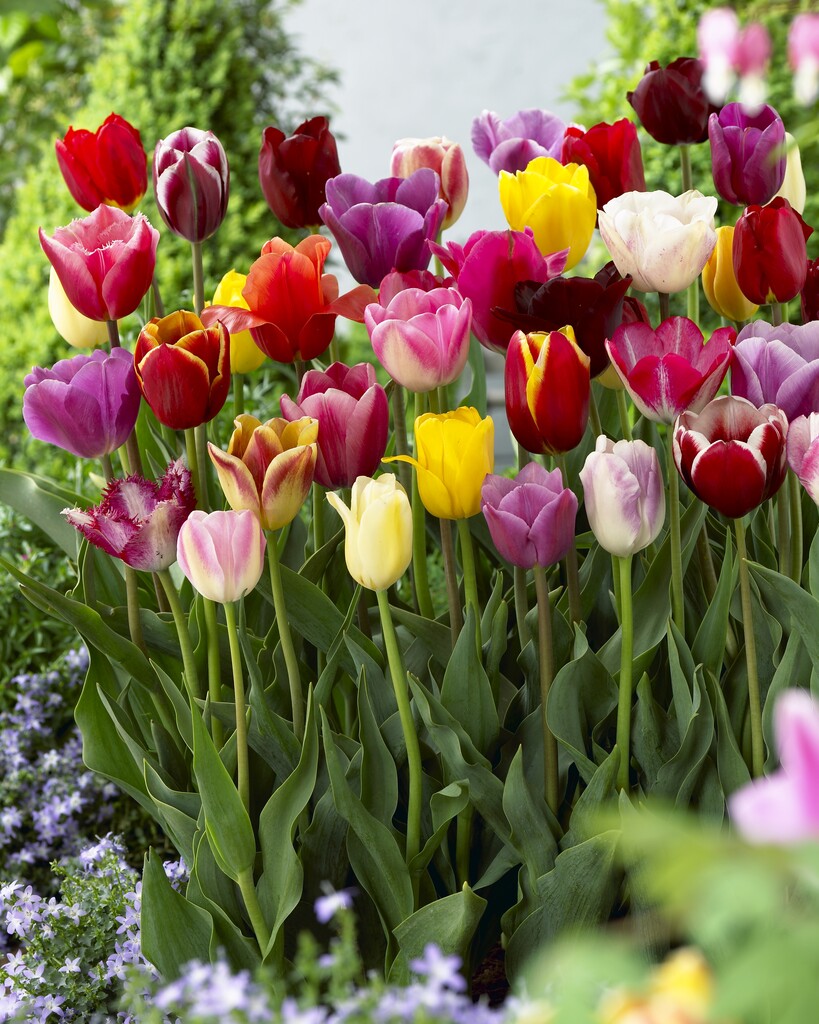
The largest tulip group is triumphs. They come in a vast range of colors and patterns, especially highlighted in our Pastel Tulip Mix that is filled with beautiful blooms in delicate color shades. Midseason bloomers with sturdy stems, they’re excellent for cut flowers and stand up well to spring winds. Our selection of triumph tulips is found here.
Key characteristics:
- Bloom time: Mid-spring
- Height: 14–20 inches tall
- Flower form: Classic single cup shape with smooth petals
Darwin Hybrid Tulips (Spring)
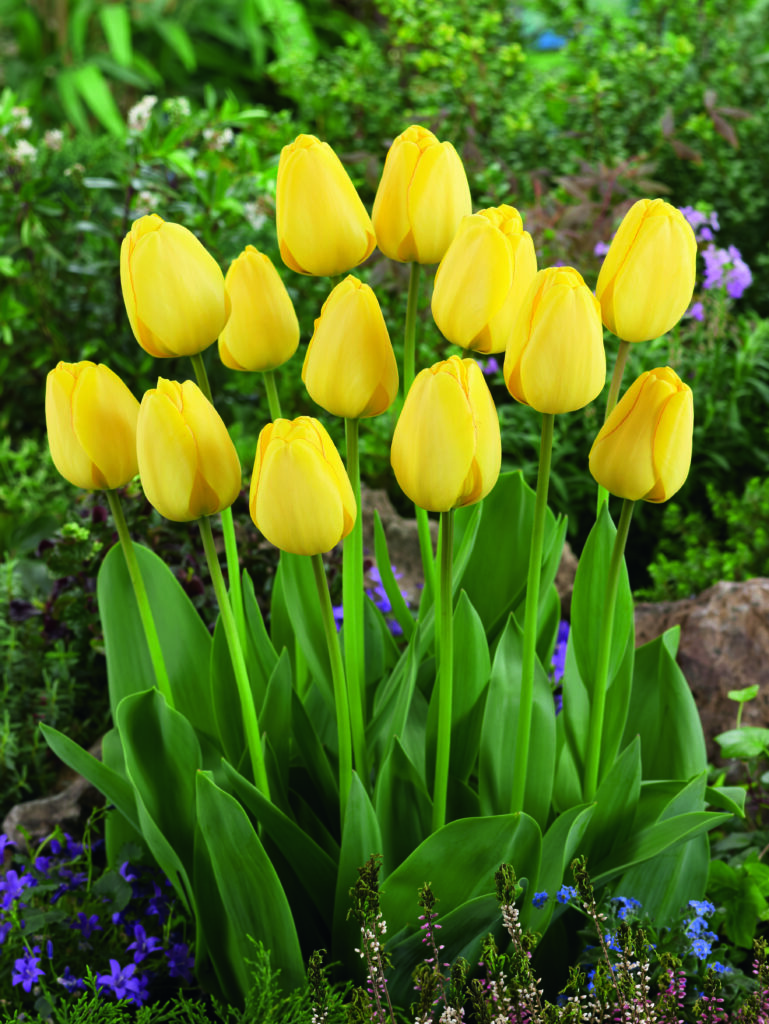
Known as the giants of the tulip world, Darwin hybrids offer tall, strong stems and huge, egg-shaped blooms. Just take a look at Red Impression Tulips! Their reliability makes them a favorite among gardeners that value their long-lasting blossoms and excellent garden performance. They bloom midseason, bridging the gap between early and late varieties. Because of their height, they should not be planted in the front of gardens. Here is our selection of Darwin hybrid tulips.
Key characteristics:
- Bloom time: Mid to late spring
- Height: 18–24 inches tall
- Flower form: Large, classic cup-shaped blooms
Double Late Tulips (Late Spring)
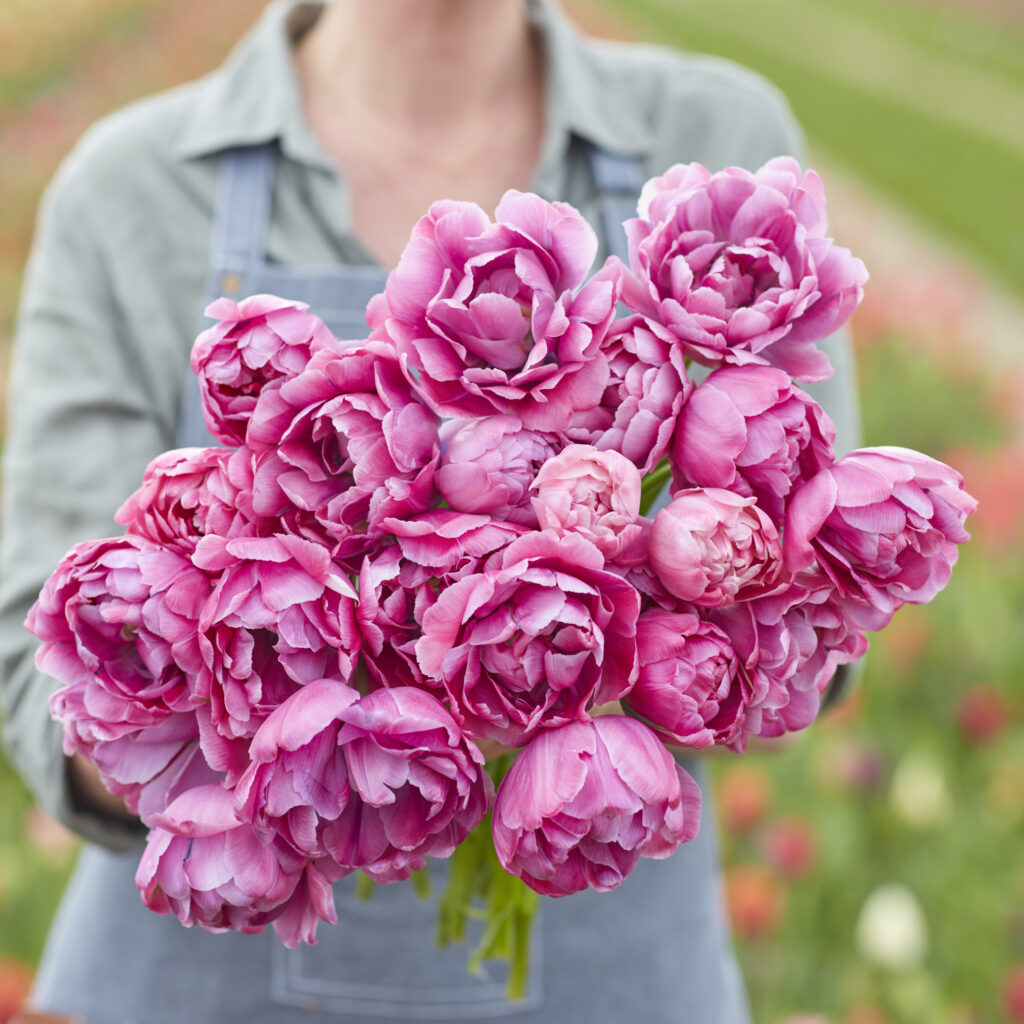
Also known as peony-flowered tulips, these lush, full blooms open toward the end of spring. Their dense petals can make them heavy, so sheltered spots work best. They bring a dramatic, romantic finale to tulip season. Double late tulips are well known for how their coloring changes as they mature from buds to open flowers, as seen in our standout Charming Beauty. In landscapes it adds to the spectacular display, especially when the color changes by the day. Here is our large selection of double late tulips.
Key characteristics:
- Bloom time: Late spring
- Height: 18–24 inches tall
- Flower form: Full, multi-layered double blooms resembling peonies
- Uses: Perfect for cutting gardens, borders, and standout displays
Single Late Tulips (Late Spring)

Tall and elegant, these occupy the closing act of the tulip show. Their blooms can be pointed or rounded and come in every color imaginable, even black as seen in our Queen of the Night tulip. Viridiflora tulips, which can be distinguished by the green feathering on the flower petals, and cottage tulips are part of the single late groups. They’re perfect for extending your tulip display into May. Find our Single Late Tulips here.
Key characteristics:
- Bloom time: Late spring (often May)
- Height: 22–28 inches tall
- Flower form: Classic single cup shape, often slightly pointed petals
- Uses: Great for borders, beds, and cut flowers
Lily Flowering Tulips (Late Spring)
These graceful late bloomers have long, narrow petals that flare into elegant points. Their star-like shape and vibrant colors bring sophistication to beds and borders. Similar to single late tulips, most are used for cut flower production and in landscapes where they perform best when planted in a more protected area and away from the front because of their height.
Key characteristics:
- Bloom time: Late spring
- Height: 18–24 inches tall
- Flower form: Narrow, pointed petals that curve outward like a lily
- Uses: Great for adding height and elegance to borders, beds, and floral arrangements
Parrot Tulips (Late Spring)
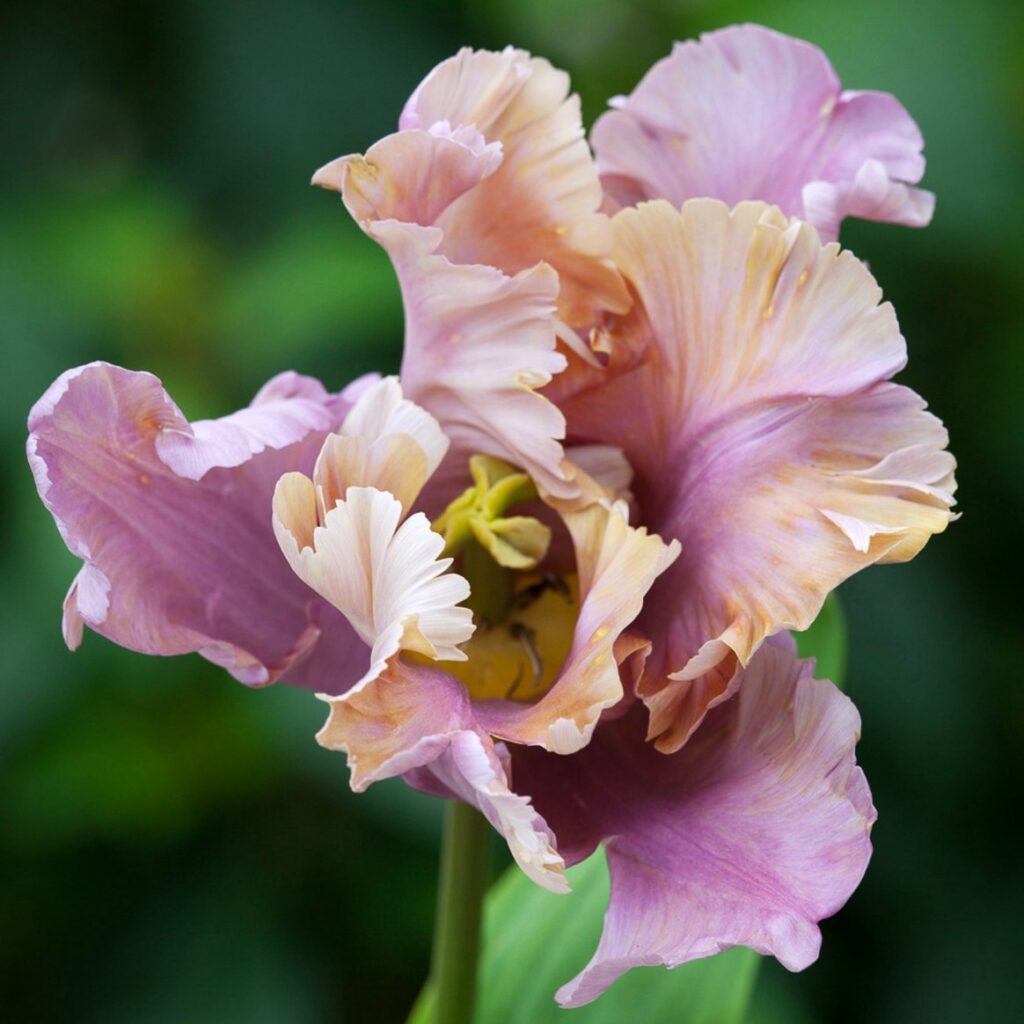
Frilled, feathered, and flamboyant, parrot tulips look like they stepped right out of a painting. Available in bold colors and streaked patterns, they’re a striking choice for the adventurous gardener. Parrot tulips are mutations, not hybrids, of existing varieties and appeared over the years of producing flower bulbs. From them others “showed up” and were registered. Apricot Parrot is a well-loved variety. Generally the flowers are large with petals that are twisted, cut, and feathered. Take a look at our selection of parrot tulips.
Key characteristics:
- Bloom time: Late spring
- Height: 18–28 inches tall
- Flower form: Large, deeply fringed and feathered petals with a curled, irregular shape
- Uses: Perfect for standout garden displays, cutting gardens, and floral arrangements that demand attention
Few flowers give gardeners a better canvas for playing with color and form than tulips. By understanding each variety’s stem height, petal shape, and bloom time, you can layer your planting for a breathtaking spring show. Planting in fall sets the stage for two to three months of evolving spring beauty—from the first early buds to the grand finale of late bloomers. Choose the varieties that excite you, and mix and match for continuous color. Don’t be afraid to experiment!